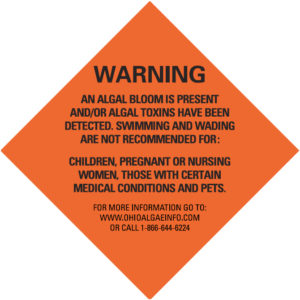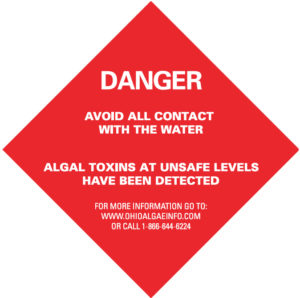Blog
Tagged In: Agriculture, Clean Water, Environmental Health, Water Pollution
The algae monster rears his ugly head at two central Ohio beaches
Adam Rissien, June 22, 2017
 NOAA is issuing predictions for a severe toxic algae season on Lake Erie (see here). However, warning signs are already going up on beaches for two of Ohio’s inland lakes due to high toxin levels from blue-green algae.
NOAA is issuing predictions for a severe toxic algae season on Lake Erie (see here). However, warning signs are already going up on beaches for two of Ohio’s inland lakes due to high toxin levels from blue-green algae.
The red placard below is the Ohio EPA’s warning for beaches with an “Elevated Recreational Public Health Advisory.” It’s the agency’s most serious ranking to inform beachgoers to stay out of the water because the risk of developing very serious health issues is extremely high. The big red signs are now posted at two Buckeye Lake beaches, which was reported by a local Columbus news station. The same signs are posted again at Grand Lake St. Marys, which has now had advisories for eight years in a row.

When toxins from blue-green algae reach certain levels, the Ohio EPA issues these warnings. The red signs are for when concentrations are dangerous for all people, and the orange signs are for when levels become a concern for children and other high risk populations.
 Toxins from blue-green algae can cause multiple symptoms including skin rashes, nausea, paralysis, neurological disorders, and damage to the kidneys and liver. Pollution from industrial livestock operations, agricultural runoff, home septic systems and overflows from city sewers are the primary sources that feed toxic algae depending on location.
Toxins from blue-green algae can cause multiple symptoms including skin rashes, nausea, paralysis, neurological disorders, and damage to the kidneys and liver. Pollution from industrial livestock operations, agricultural runoff, home septic systems and overflows from city sewers are the primary sources that feed toxic algae depending on location.

Unfortunately, this algae-causing pollution remains a serious problem in Ohio, despite science-backed, commonsense solutions that could reduce the threat. For Grand Lake St Marys and Lake Erie, industrial agriculture is the biggest contributor to the problem. Sadly, the few controls currently in place do not effectively prevent pollution from manure and fertilizer that feeds toxic algae.
 Until these sources of pollution are addressed, Ohioans will continue seeing big red and orange signs at beaches all across the state.
Until these sources of pollution are addressed, Ohioans will continue seeing big red and orange signs at beaches all across the state.
